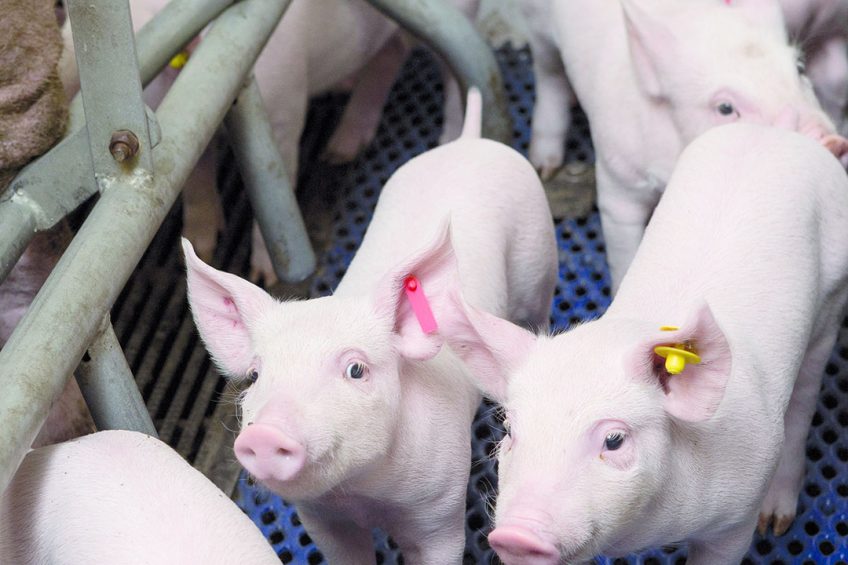Pig feed formulations for antibiotic-free production

In North America, antibiotic-free pig production causes nutritional challenges. Regulations in Canada are being eased to allow the use of some ingredients already available internationally. An update.
Little is known about the long-term consequences of withdrawing prophylactic antibiotics from pig feed, according to Dr Diana Alessia of the Teagasc Animal and Grassland Research and Innovation Centre in Ireland. However, Dr Alessia and her colleagues recently found that the removal of these antibiotics is possible with only minor reductions in productive performance and health, which can be addressed by improved husbandry and the use of parenteral antibiotics.
Nutrient levels in diets haven’t changed much over the years – the main difference is how these nutrients are provided.” – Stacie Crowder, Land O’Lakes.
Raised-without-antibiotics (RWA) production
Feed is obviously also a critical aspect of successful raised-without-antibiotics (RWA) production. Such feeds have been in development for many years around the world, by companies such as Grand Valley Fortifiers in Cambridge, Ontario, Canada. More than a decade ago, Grand Valley partnered with Loblaw, one of Canada’s largest food companies, as the feed company liaison between Loblaw and producers contracted to rear pigs for Loblaw’s President’s Choice brand ‘Free From’ pork products.
Grand Valley Fortifiers’ monogastric nutritionist Bruce Schumann notes that many components of RWA feed – probiotics, herbal extracts and more – promote good gut development and function. “However, because of the difficulty involved in registering novel bacteria in Canada, not much has evolved when it comes to probiotics. It’s a matter of finding the best ones that are available in the market and coupling them with prebiotics.”
Additives emerged at an increasing rate
Stacie Crowder, lead nutritionist for swine technical innovations across Land O’Lakes firms, notes that many additives have emerged and at an increasing rate in the RWA feed space over the past few years, but with limited success.
These additives include:
- yeast products
- organic acids
- enzymes
- phytogenics
- flavouring
- medium-chained fatty acids
- fermentation by-products.
Crowder says their approach is to focus on the microbiome, intestinal function and the immune system. “Our nutritionists, who have started to look at diet formulations in a new way, are taking a total nutrition approach,” she reports. “Nutrient levels in diets haven’t changed much over the years – the main difference is how these nutrients are provided. This has led to an increased focus on ingredient sourcing, as there is value in understanding the differences in digestibility, which will lead to more effective diet formulations.”
Crowder also explains that additives can be highly effective at low inclusions levels. “Nursery formulations have been used where the majority of in-feed antibiotics are included in swine nutrition,” she says. “Those formulas are very complex and space in the diet is at a premium. That’s why inclusion and mode of action are extremely important.”
…the control of oxidative stress is increasingly recognised as an essential strategy for reaching full genetic potential.” – Aimé Roy, Alltech.
Other critical aspects
At Alltech, a primary focus in RWA feed development is achieving an ideal stomach pH in pigs after weaning. This starts digestive enzyme secretion as soon as possible, leaving less undigested nutrient for pathogens, explains Aimé Roy, Alltech technical swine liaison in Canada. Another critical aspect for Roy in RWA feed manufacture is mycotoxins.
“Most of the time, we underestimate the negative effects of mycotoxins that are detrimental to the immune system,” he says. In addition, “the control of oxidative stress is increasingly recognised as an essential strategy for reaching full genetic potential.” Alltech US swine business leader Russell Gilliam notes that for successful RWA feed development and use, the firm’s ‘production teams’ play a big role, as they help the firm’s nutrition and veterinary team keep abreast of any challenges that develop, and this makes quick changes in the plan of action possible. “There are several [pork production] companies that have been very successful at doing this and I believe that a lot of their success stems from making sure that everyone on the team is engaged and all opinions and ideas are seen as having value as the plan is put into place.”

Meeting the challenges in feed production
In terms of what’s been most challenging in making feed that optimises the performance of pigs in RWA production, Schumann lists respiratory disease as a long-term issue that still lingers. “Although we can boost the pigs’ immune response with antioxidants such as Vitamin E and selenium, and take care of the gut with many nutritional technologies,” he explains, “respiratory disease is still a serious threat. Better environmental controls and better husbandry are very important.”
The second-largest challenge in Schumann’s view is developing feeds for piglets that suffer from typical post-wean scour: “Especially given that the industry will be significantly restricted in the amount of zinc that can be used.” Another challenge noted by Roy is to reduce the amount of undigested nutrients in the digestive tract of nursery pigs – nutrients that are thus available for pathogens like E. coli to feed on. She says a viable strategy for this could involve reducing crude protein content through the incorporation of synthetic amino acids such as valine.
Looking ahead
Like all feed companies, Grand Valley constantly examines new ingredients. In Canada, there will be more of those to analyse in the near future. Schumann explains that the Canadian Food Inspection Agency (CFIA) is in the process of easing some regulatory restrictions on feed ingredients and that some products that have been available internationally for quite a while will be receiving registration in Canada – in particular, probiotics blends and acid blends.
The use of dried fermentation products
Schumann believes that RWA production should get easier as the number of vaccines continues to grow. Also important, in his view, will be the use of dried fermentation products that reduce the severity of a disease challenge mounted by a pathogen population. These products prevent ‘quorum sensing,’ where pathogens sense their own numbers and at a certain density, are triggered to start a disease process in the host. For her part, Crowder believes there will be an increased focus on “nutritional immunology” in animal production, meaning an increased “understanding of how we can better support the immune system of an animal through nutrition.”
She also believes “we’ll see an increase of non-nutritional additives focused on health, environment and biosecurity on the farm, as well as food safety. These haven’t so far been a focus on the nutritional side of feed formulation, but will be an area in which nutritionists will play a key role in the future.”











